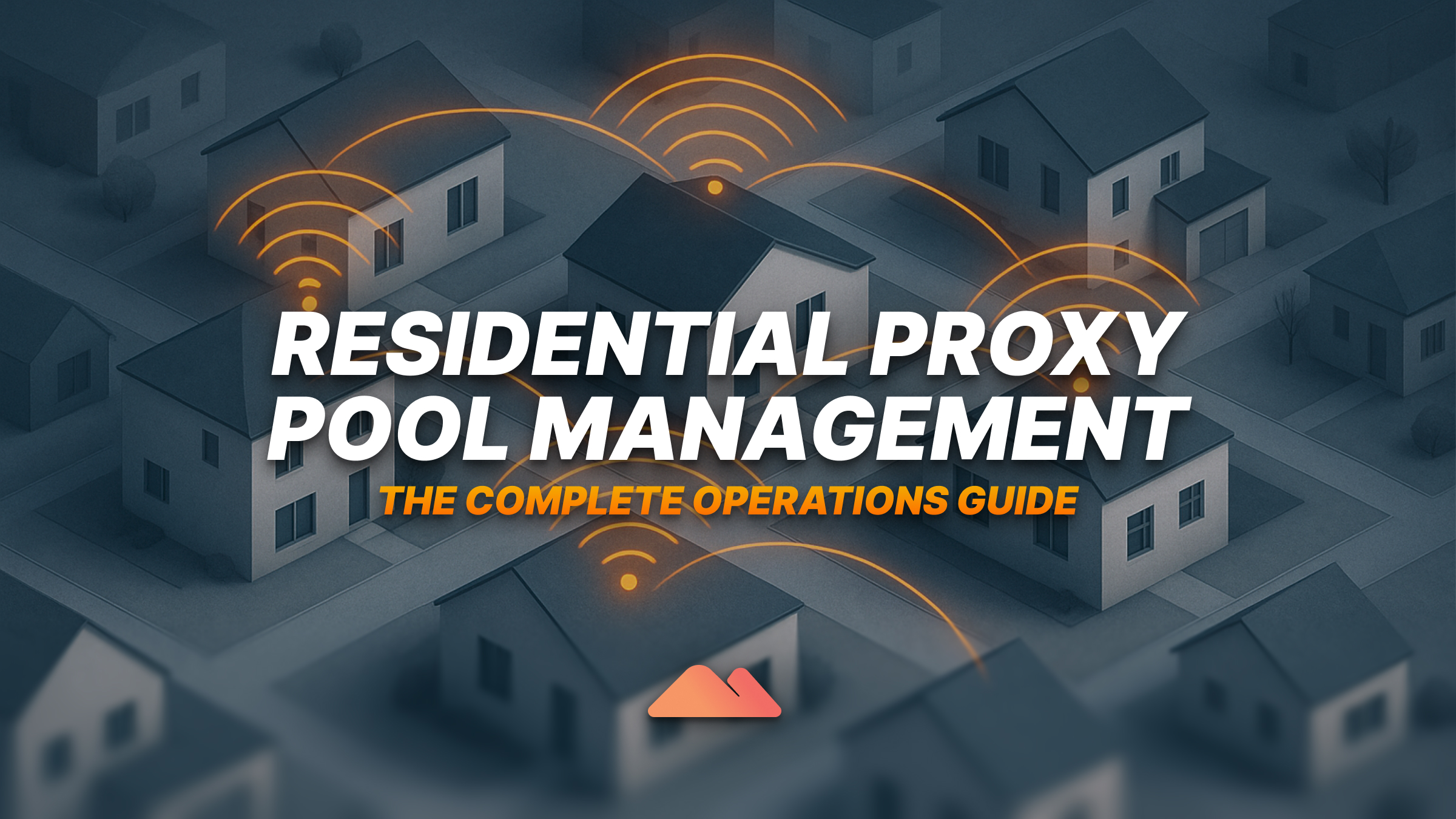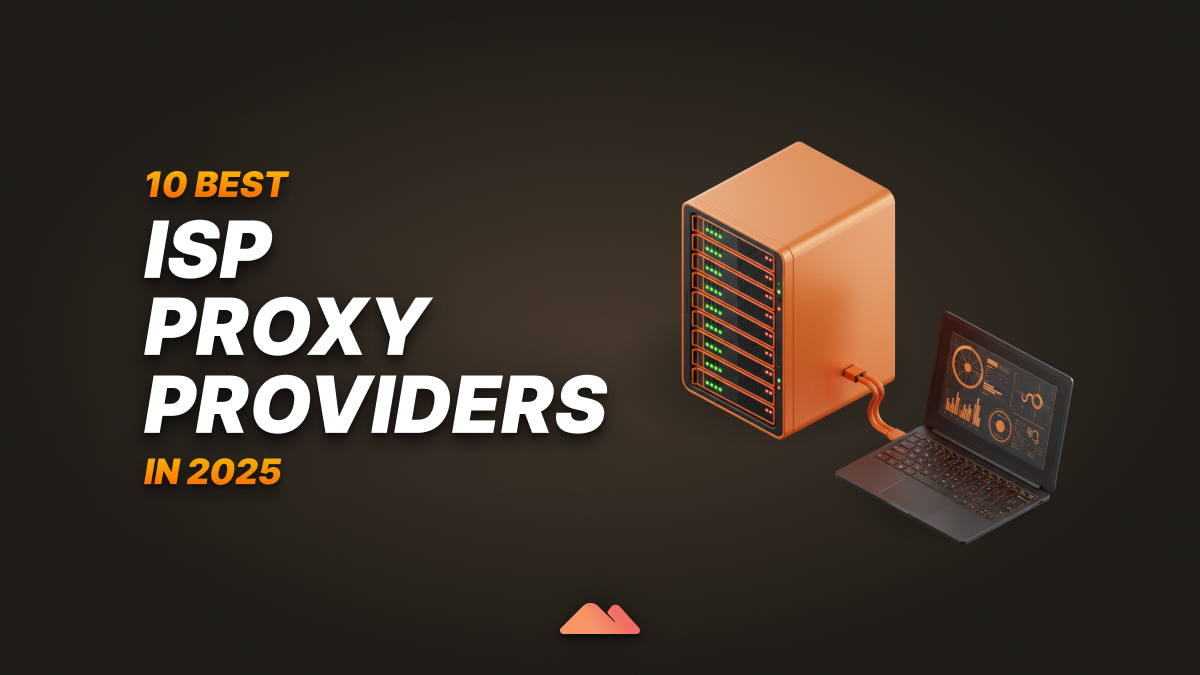TL;DR
O gerenciamento de pools de proxy residencial é a operação estratégica de milhares a milhões de endereços IP residenciais legítimos para permitir a coleta de dados em grande escala. O sucesso exige segmentação de pool multidimensional (níveis de desempenho, diversidade de ISP, precisão geográfica), monitoramento contínuo da qualidade (mais de 85% de taxas de sucesso no comércio eletrônico, mais de 78% nas mídias sociais) e estratégias de rotação sofisticadas.
Os principais requisitos operacionais incluem pontuação de qualidade automatizada, estruturas de conformidade para GDPR/CCPA e seleção de IP baseada em aprendizado de máquina. A maioria das operações falha devido à segmentação deficiente, ao monitoramento inadequado ou ao tratamento do gerenciamento de proxy como uma mercadoria, em vez de uma competência essencial que exige infraestrutura e experiência dedicadas.
O que é um pool de proxy?
Um pool proxy é uma coleção gerenciada de servidores proxy que atuam como intermediários entre seus aplicativos e sites de destino, fornecendo redundância, escalabilidade e tratamento distribuído de solicitações, essenciais para as operações de coleta de dados corporativos. Embora os pools de proxy atendam a várias funções em diferentes setores, este guia se concentra especificamente nas estratégias avançadas de gerenciamento necessárias para operações de proxy residenciais em grande escala.
Pools proxy residenciais diferem fundamentalmente dos pools de datacenters tradicionais ao obter IPs de conexões domésticas legítimas à Internet. Compreensão o que torna um proxy residencial único é crucial para o gerenciamento eficaz de pools, pois esses pools contêm endereços IP atribuídos pelos principais ISPs a clientes residenciais reais que consentiram em compartilhar sua conexão. Essa autenticidade torna os pools residenciais significativamente mais eficazes para acessar conteúdo protegido, mas introduz complexidade no gerenciamento, na conformidade e na consistência operacional, o que exige um tratamento sofisticado.
Os pools de proxy residenciais modernos operam como sistemas distribuídos que combinam várias camadas de infraestrutura: gerenciamento de fontes IP lidando com mais de 50.000 a 500.000 terminais residenciais, infraestrutura de gateway gerenciando roteamento de solicitações e balanceamento de carga e camadas de gerenciamento inteligente que fornecem pontuação de qualidade, roteamento geográfico e monitoramento de conformidade.
A característica mais valiosa das piscinas residenciais é sua autenticidade comportamental: esses IPs têm histórico de navegação legítimo, cookies de sessões reais de usuários e padrões comportamentais que correspondem ao uso genuíno da Internet pelo consumidor. No entanto, diferentemente dos proxies de datacenter com desempenho consistente, os endpoints residenciais apresentam disponibilidade dinâmica com base nos padrões de atividade do usuário e na variabilidade de desempenho, dependendo da qualidade da conexão e do congestionamento da rede.
Gerenciar pools de proxy residenciais em grande escala não significa apenas ter milhares de IPs, mas sim orquestrar um ecossistema complexo que oferece desempenho consistente e, ao mesmo tempo, mantém a autenticidade que torna os proxies residenciais inestimáveis. Este guia abrangente detalha os elementos estratégicos e táticos que separam as operações bem-sucedidas daquelas que enfrentam bloqueios, problemas de conformidade e baixo ROI.
A base: arquitetura e segmentação de piscinas
Componentes principais do pool
Os pools proxy residenciais modernos operam em três camadas fundamentais que trabalham juntas para criar uma infraestrutura autêntica e escalável:
Camada de rede ponto a ponto forma a fonte IP primária, normalmente representando de 60 a 70% da maioria dos pools de alta qualidade. Esses IPs vêm de usuários residenciais legítimos que optaram por compartilhar sua conexão. As principais métricas aqui incluem distribuição geográfica, diversidade de ISPs e taxas de retenção de usuários. Os principais fornecedores mantêm mais de 85% de retenção de usuários mensalmente, indicando modelos de compensação sustentáveis e impacto mínimo no usuário.
Camada NAT de nível de operadora (CGN) fornece 20-25% dos IPs que oferecem maior estabilidade e desempenho previsível. Embora menos “residenciais” no sentido tradicional, os endpoints CGN dos principais ISPs fornecem estabilidade crucial para sessões de longa duração. Esses IPs geralmente mostram a duração média das sessões de 40 a 60 minutos, em comparação com 8 a 15 minutos para terminais residenciais padrão.
Integração de rede móvel representa o segmento que mais cresce, com 10 a 15% das piscinas premium. Proxies móveis oferecem vantagens exclusivas para plataformas que priorizam dispositivos móveis, mas exigem estratégias de rotação sofisticadas devido à sua natureza dinâmica. Os endpoints móveis mostram taxas de sucesso 23% maiores em plataformas de mídia social, mas 15% menor desempenho em sites de comércio eletrônico tradicionais.
Estrutura de segmentação estratégica
A segmentação efetiva vai muito além da distribuição geográfica. As operações mais bem-sucedidas implementam a segmentação multidimensional com base em:
Níveis de desempenho: Classifique os IPs nas categorias Gold (95% + taxa de sucesso), Silver (85-94% de taxa de sucesso) e Bronze (75-84% de taxa de sucesso). Os IPs de nível Gold, representando cerca de 15 a 20% da maioria dos pools, são reservados para operações de alto valor em que falhas não são aceitáveis. O nível Silver lida com operações padrão, enquanto o nível Bronze atende a ambientes de desenvolvimento e teste.
Categorias específicas do alvo: Sites diferentes exigem características de IP diferentes. As plataformas de mídia social favorecem IPs móveis e residenciais com agentes de usuário consistentes, enquanto os sites de comércio eletrônico têm melhor desempenho com IPs padrão de desktop que mostram durações de sessão mais longas. O monitoramento de SEO se beneficia de IPs com mínima atividade de pesquisa anterior.
Segmentação baseada em ISP: Cada um dos principais ISPs, como Comcast, Verizon e AT&T, tem características e tolerâncias de detecção diferentes. Os endpoints da Comcast normalmente apresentam um desempenho 18% melhor em plataformas de streaming, enquanto os IPs da Verizon se destacam na coleta de dados de serviços financeiros.
Métricas e monitoramento de qualidade
Indicadores essenciais de desempenho
Taxa de sucesso por domínio de destino fornece a visão mais prática sobre a qualidade da piscina. Acompanhe essa métrica em pelo menos 50 domínios principais em suas categorias de destino. Uma piscina residencial saudável deve manter mais de 85% de taxas de sucesso nos principais sites de comércio eletrônico, mais de 78% em plataformas de mídia social e mais de 92% em sites de notícias e informações gerais. Esses benchmarks se alinham com padrões de desempenho da indústria para operações de procuração residencial.
Consistência do tempo de resposta importa mais do que a velocidade bruta para proxies residenciais. O desvio padrão deve permanecer abaixo de 500 ms para 90% das solicitações na mesma região geográfica. Tempos de resposta inconsistentes geralmente indicam problemas de infraestrutura ou problemas de reputação de IP que se transformarão em blocos.
Verificação de precisão geográfica requer monitoramento contínuo em vários bancos de dados de geolocalização. MaxMind, IP2Location e IPInfo devem concordar com a localização dentro de 50 milhas para pelo menos 95% de sua piscina. Dados de geolocalização incompatíveis acionam sistemas de detecção sofisticados usados pelas principais plataformas.
Pontuação de qualidade avançada
Implemente um índice de qualidade composto combinando vários fatores:
- Taxa de sucesso histórica (40% do peso): Percentual de sucesso contínuo de 7 dias em todas as operações
- Precisão geográfica (25% de peso): Consistência entre bancos de dados de geolocalização
- Consistência comportamental (20% de peso): Padrões de resposta que correspondem ao comportamento residencial esperado
- Status de reputação (peso de 15%): Ausência nas principais listas de bloqueio e bancos de dados antifraude
Os IPs com pontuação abaixo de 70 devem ser automaticamente colocados em quarentena para análise, enquanto aqueles acima de 85 recebem alocação prioritária para operações críticas.
Implementação de monitoramento em
Implante sondas de monitoramento que testam a integridade do pool a cada 15 minutos em locais-alvo representativos. Os principais pontos de monitoramento incluem:
- Sucesso na autenticação: Os IPs podem concluir com êxito os fluxos de login nas principais plataformas?
- Frequência CAPTCHA: Com que frequência as solicitações acionam desafios de CAPTCHA?
- Limites de limitação de taxa: Com que frequência de solicitação os sites começam a bloquear IPs?
- Persistência da sessão: Os IPs mantêm um comportamento consistente em sessões prolongadas?
Caso de uso: Deep Dives
Monitoramento de preços de e-commerce
Desafio: sites de varejo implementam detecção sofisticada de bots combinando reputação de IP, padrões de navegação e análise de tempo de solicitação.
Requisitos de piscina:
- Mínimo de 10.000 IPs por grande mercado geográfico
- Diversidade de ISPs sem um único provedor que exceda 15% da alocação regional
- Capacidade de persistência da sessão por 20 a 45 minutos
- Alocação de IP móvel de pelo menos 30% para corresponder aos padrões de compra
Estratégia operacional: implemente um tempo de solicitação escalonado que imite o comportamento humano de navegação. As solicitações devem chegar com intervalos de 15 a 45 segundos com variação aleatória. Manter sessões de carrinho de compras por 15 a 20 minutos antes da rotação para evitar o acionamento de sistemas de detecção de abandono. Para organizações novas em operações de procuração residencial, técnicas de implementação adequadas são essenciais para alcançar esses padrões comportamentais e, ao mesmo tempo, evitar erros comuns de configuração que levam a bloqueios.
Métricas de sucesso: Alcance uma taxa de sucesso de mais de 88% em varejistas de nível 1 (Amazon, Walmart, Target), sem que nenhum IP único gere mais de 50 solicitações por hora por domínio.
Inteligência de mídia social
Desafio: As plataformas sociais empregam modelos de aprendizado de máquina que analisam padrões de comportamento do usuário, impressões digitais de dispositivos e características da rede para identificar o acesso automatizado.
Requisitos de piscina:
- Alocação pesada de IP móvel (mais de 60% das solicitações)
- Agrupamento geográfico que corresponde aos dados demográficos da plataforma
- Suporte para sessões persistentes com duração de 45 a 90 minutos
- Integração com a rotação residencial de usuários-agentes
Estratégia operacional: mantenha personalidades de usuário consistentes em todas as sessões, incluindo impressões digitais do navegador, comportamento de fuso horário e padrões de interação. Interações espaciais de 2 a 8 minutos com padrões de engajamento realistas, incluindo simulação de rolagem e interação de conteúdo variada.
Métricas de sucesso: Alcance uma taxa de sucesso de mais de 82% nas principais plataformas com duração média de sessão superior a 35 minutos antes da rotação.
Dados de desempenho: As operações que usam piscinas residenciais com uso intenso de dispositivos móveis mostram 34% menos bloqueios no Instagram e 28% menos no TikTok em comparação com as abordagens somente para desktop, com a duração média das sessões de 47 minutos versus 23 minutos para estratégias mistas de dispositivos móveis/desktop.
Monitoramento de SEO e SERP
Desafio: os mecanismos de pesquisa implementam análise de padrões de consulta e validação de consistência geográfica que podem detectar sistemas de monitoramento automatizados.
Requisitos de piscina:
- Distribuição geográfica real correspondente aos mercados-alvo de pesquisa
- Baixa frequência de consultas por IP (máximo de 12 pesquisas por IP por dia)
- Tipos de dispositivos mistos que refletem o comportamento natural de pesquisa
- Limpe o histórico de IP com o mínimo de atividade de pesquisa anterior
Estratégia operacional: distribua consultas entre regiões geográficas durante os horários de pico locais. Implemente padrões de pesquisa realistas, incluindo consultas relacionadas, navegação na página de resultados e pesquisas ocasionais não direcionadas, para manter a autenticidade comportamental.
Métricas de sucesso: mantenha uma taxa de sucesso de mais de 94% com dados de classificação consistentes em todos os mercados geográficos.
Resultados de otimização: UMA Operação de monitoramento SERP reduziram os falsos positivos em 67% quando implementaram a distribuição de consultas com reconhecimento de fuso horário, garantindo que as pesquisas ocorressem em horários realistas para cada mercado geográfico.
Pesquisa de mercado e geração de leads
Desafio: Plataformas B2B e redes profissionais implementam sistemas de detecção complexos que analisam padrões de conexão, frequência de interação de perfil e correlação comportamental entre plataformas.
Requisitos de piscina:
- Alocação de ISP corporativo refletindo padrões comerciais da Internet
- Capacidade de sessão estendida (60 a 120 minutos)
- Precisão geográfica no nível da cidade para segmentação baseada em localização
- Integração com simulação de padrões de navegação profissional
Estratégia operacional: espelhe o comportamento de navegação profissional com tempos de permanência de página mais longos, downloads de documentos e padrões de navegação realistas. Mantenha personalidades profissionais consistentes em todo o mundo sessões de pesquisa estendidas.
Métricas de sucesso: Alcance uma taxa de sucesso de mais de 76% em plataformas profissionais com produtividade média de pesquisa de sessão de mais de 40 pontos de dados por sessão.
Operações de escalabilidade
Requisitos de infraestrutura por escala
Pequenas operações (1-10 milhões de solicitações/mês):
- Mínimo de 5.000 IPs residenciais em mais de 3 países
- Lógica básica de rotação com persistência de sessão de 15 minutos
- Monitoramento manual da qualidade com relatórios semanais de saúde da piscina
- Distribuição geográfica: 60% nos EUA, 25% na UE, 15% em outros mercados importantes
Operações médias (10 a 100 milhões de solicitações/mês):
- Mais de 25.000 IPs residenciais com controle geográfico no nível da cidade
- Sistemas automatizados de pontuação de qualidade e quarentena de IP
- Segmentação de pool específica para o alvo com otimização de desempenho
- Gerenciamento avançado de sessões com suporte a várias operações simultâneas
Grandes operações (mais de 100 milhões de solicitações/mês):
- Mais de 100.000 IPs residenciais com cobertura global abrangente
- Seleção de IP baseada em aprendizado de máquina e otimização de rotação
- Monitoramento de desempenho em tempo real com escalabilidade automatizada
- Automação de conformidade com rastreamento de requisitos regulatórios
Exemplos de crescimento de piscinas no mundo real
A demanda por pools de proxy residenciais cresceu exponencialmente à medida que os requisitos de coleta de dados se tornaram mais sofisticados. Pool IP residencial da Massive demonstra essa tendência, expandindo de 50.000 IPs globalmente em novembro de 2023 para mais de 1,6 milhão de IPs em julho de 2025 — um aumento de 3.100% em apenas 20 meses. Somente o mercado dos EUA cresceu de 3.000 IPs diários em abril de 2024 para quase 400.000 IPs diários, enquanto a cobertura internacional agora abrange 1,2 milhão de IPs nos principais mercados globais.
%20(EN).png)
Esse crescimento explosivo ilustra por que o gerenciamento automatizado de piscinas se torna essencial em escala empresarial. O gerenciamento diário de mais de 396.000 IPs dos EUA e mais de 1,2 milhão de endpoints internacionais exige automação sofisticada para pontuação de qualidade, distribuição geográfica, gerenciamento da diversidade de ISPs e otimização do desempenho em tempo real.
Gerenciamento automatizado de piscinas
Implemente sistemas automatizados que lidam com tarefas de gerenciamento de rotina:
Automação de avaliação de qualidade: implante scripts que testam amostras aleatórias de IP a cada 2 horas em relação a um conjunto de metas padronizado. Coloque automaticamente em quarentena os IPs que mostram um declínio nas taxas de sucesso ou padrões de resposta incomuns.
Inteligência de distribuição de carga: use algoritmos que considerem a atualização do IP, o histórico recente de sucesso e o desempenho específico do alvo ao alocar solicitações. Sistemas bem-sucedidos alcançam uma utilização de recursos de 15 a 25% melhor em comparação com abordagens simples de rodízio.
Manutenção preditiva: analise as tendências de desempenho de IP para prever falhas antes que elas afetem as operações. Os IPs que mostram um desempenho decrescente ao longo de 72 horas normalmente requerem períodos de resfriamento de 48 horas para restaurar a eficácia total.
Estratégias de otimização de desempenho
Otimização da sessão: mantenha análises detalhadas sobre a duração ideal das sessões por tipo de alvo. O monitoramento de comércio eletrônico funciona melhor com sessões de 25 a 35 minutos, enquanto a inteligência de mídia social se beneficia de sessões de 45 a 75 minutos.
Solicite inteligência de cronometragem: implemente um cronograma sofisticado que leve em conta os padrões de carga do servidor alvo, os fusos horários geográficos e o comportamento realista do usuário. O desempenho máximo ocorre quando o tempo de solicitação corresponde aos padrões de atividade esperados do usuário para a localização reivindicada de cada IP.
Automação de recuperação de falhas: crie sistemas que repitam automaticamente as solicitações que falharam usando segmentos IP diferentes. Implemente o retrocesso exponencial com a seleção inteligente de IP que evita endpoints que falharam recentemente.
Conformidade e gerenciamento de riscos
Estrutura de conformidade regulatória
Conformidade de proteção de dados: Os requisitos do GDPR e da CCPA se estendem às operações de proxy quando os dados pessoais são coletados por meio de IPs residenciais. Implemente princípios de minimização de dados e garanta que todos os dados coletados tenham uma finalidade comercial legítima com políticas de retenção apropriadas.
Ética da rede de pares: Mantenha processos transparentes de consentimento do usuário e modelos de compensação justos. As redes de pares com melhor desempenho mostram mais de 90% de pontuação de satisfação do usuário e taxas de retenção voluntária superiores a 85%.
Conformidade geográfica: Diferentes jurisdições têm requisitos variados para operações de procuração. As operações da UE exigem o consentimento explícito do usuário e acordos de processamento de dados, enquanto alguns mercados asiáticos têm restrições à coleta de dados transfronteiriça.
Estratégias de mitigação de riscos
Monitoramento de reputação de IP: monitore continuamente seu pool em relação às principais listas de bloqueio e bancos de dados de reputação. Implemente a remoção automática de IPs que aparecem no Spamhaus, SURBL ou em outros sistemas importantes de reputação.
Aplicação de limitação de taxa: implemente uma limitação de taxa por IP e por alvo que impede que operações individuais queimem IPs valiosos por meio de volumes excessivos de solicitações.
Manutenção da trilha de auditoria: mantenha registros abrangentes de alocação de IP, padrões de solicitação e taxas de sucesso/falha para relatórios de conformidade e otimização da operação.
Técnicas avançadas de otimização
Integração de aprendizado de máquina
Seleção preditiva de IP: treine modelos com base em dados históricos de desempenho para prever quais IPs serão bem-sucedidos em metas específicas. Os sistemas avançados alcançam uma melhoria de 20 a 30% nas taxas de sucesso na primeira solicitação.
Otimização de padrões comportamentais: use o ML para identificar e replicar padrões de navegação bem-sucedidos que evitam a detecção. Modelos treinados em sessões bem-sucedidas podem orientar o tempo de solicitação e os padrões de interação.
Detecção de anomalias: implante sistemas que identifiquem padrões incomuns no desempenho de IP ou almeje respostas que possam indicar sistemas de detecção emergentes ou problemas de qualidade do pool.
Estratégias de integração
Integração de CRM e inteligência de vendas: combine operações de procuração residencial com sistemas de gerenciamento de relacionamento com clientes para melhorar a qualidade dos leads e reduzir os riscos de detecção durante a pesquisa de clientes potenciais.
Conexão à plataforma de inteligência de negócios: alimente dados de desempenho de proxy em sistemas de BI mais amplos para identificar correlações entre o sucesso da coleta de dados e os resultados comerciais.
Integração do gerenciamento de conformidade: conecte as operações de proxy às plataformas de gerenciamento de conformidade para garantir que os requisitos normativos sejam atendidos em todas as atividades de coleta de dados.
Embrulhando
A complexidade do gerenciamento de pools proxy residenciais continua aumentando à medida que a tecnologia e as regulamentações evoluem. As organizações que investem em sistemas de gerenciamento sofisticados, estruturas de conformidade abrangentes e processos de otimização contínua manterão vantagens competitivas, enquanto aquelas que tratam o gerenciamento de proxy como uma simples implementação técnica enfrentarão problemas de desempenho, conformidade e custo.
O sucesso no gerenciamento de pools proxy residenciais exige tratá-lo como uma competência operacional essencial, em vez de um serviço básico. As estratégias descritas neste guia refletem as lições aprendidas com o gerenciamento de pools em várias escalas, desde operações de startups até fornecedores corporativos como a Massive, cuja infraestrutura de proxy residencial atende clientes em todos os setores que exigem soluções de coleta de dados confiáveis e compatíveis.
As estruturas e as melhores práticas detalhadas aqui fornecem a base para a criação de operações de proxy escaláveis, compatíveis e de alto desempenho que oferecem valor comercial consistente em um cenário cada vez mais sofisticado.

Sou cofundador e CEO da Massive. Além de trabalhar em startups, sou músico, atleta, mentor, organizador de eventos e voluntário.
Avaliações de clientes
Pergunta mais frequente
What size residential proxy pool do I need for my operation?
+
Pool size depends on request volume and target diversity. Basic operations (under 1M requests monthly) need 5,000-10,000 IPs. Medium-scale operations (10-100M requests) require 25,000-50,000 IPs. Enterprise operations (100M+ requests) need 100,000+ IPs. Quality segmentation across ISPs and regions matters more than raw size—a well-managed 20,000 IP pool often outperforms a poorly managed 100,000 IP pool.
How do I measure residential proxy pool quality?
+
Track success rates by target domain: aim for 85%+ on e-commerce sites, 78%+ on social media, 92%+ on general content sites. Monitor geographic accuracy (95%+ agreement across geolocation databases), response time consistency (under 500ms standard deviation), CAPTCHA frequency, and IP reputation scores. Implement automated quality scoring combining these metrics with weighted importance based on your use cases.
What's the difference between sticky sessions and rotating IPs?
+
Sticky sessions maintain the same IP for 10-60 minutes, ideal for e-commerce monitoring and authenticated sessions requiring behavioral consistency. Rotating IPs change with each request, better for high-volume operations needing request distribution. Most successful operations combine both strategies—sticky sessions for specific workflows, intelligent rotation for background operations.
How do I ensure compliance when using residential proxy pools?
+
Ensure your provider obtains explicit user consent for GDPR/CCPA compliance. Implement data minimization principles and clear retention policies. Maintain comprehensive audit trails of IP allocation and data collection activities. Consider industry-specific regulations (PCI DSS, HIPAA) and conduct regular compliance reviews. Legal consultation helps navigate evolving regulatory requirements across jurisdictions.
What causes residential proxy IPs to get blocked?
+
Common causes include excessive request rates (limit to 20-50 requests per hour per IP per domain), unusual browsing patterns, geographic inconsistencies between IP location and user behavior, IP reputation issues from previous abuse, and poor session management creating unnatural behavior patterns. Prevention requires intelligent rate limiting, realistic behavior simulation, and continuous IP reputation monitoring.
How much should I expect to pay for quality residential proxy pools?
+
Budget providers: $3-8 per GB (poor performance, high block rates). Standard proxies: $10-20 per GB (reasonable quality, basic features). Premium pools: $25-50 per GB (superior success rates, advanced targeting, comprehensive compliance). Consider total cost of ownership including infrastructure and operational overhead. Higher-quality pools typically deliver better ROI through reduced complexity and higher success rates.
Can I mix residential and datacenter proxies in the same operation?
+
Yes, when implemented strategically. Use residential proxies for high-protection targets with sophisticated bot detection, datacenter proxies for less sensitive operations requiring speed and lower cost. Never mix proxy types against the same target domains. Maintain strict separation by target type, geographic region, or operational phase. Ensure your infrastructure can manage different authentication methods and rotation strategies simultaneously.
How do I handle proxy pool performance issues?
+
Start by segmenting performance data by geographic region, ISP, and target domain to identify problem areas. Implement automated monitoring testing pool health every 15 minutes. Check IP reputation against major blocklists, analyze request patterns for rate limiting violations, and consider cooling periods for overused IPs. Maintain detailed performance baselines to identify trends before they significantly impact operations.









